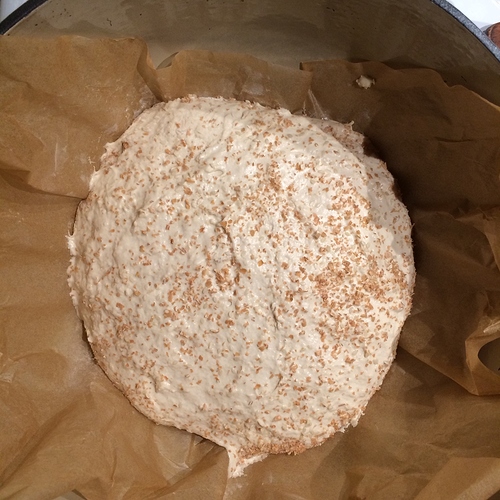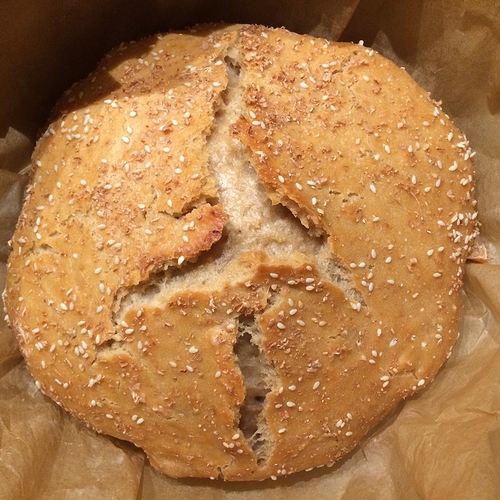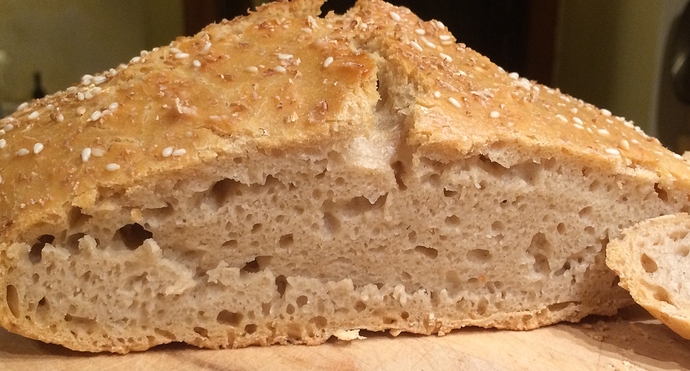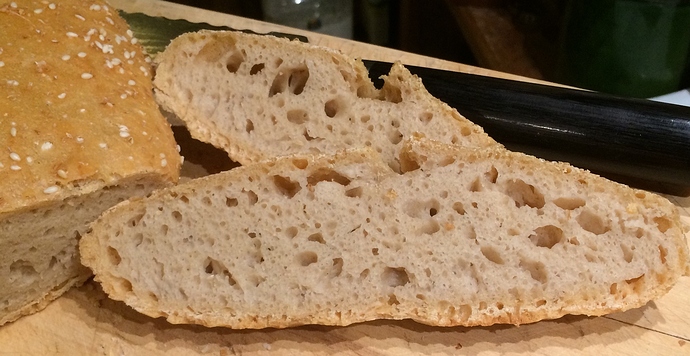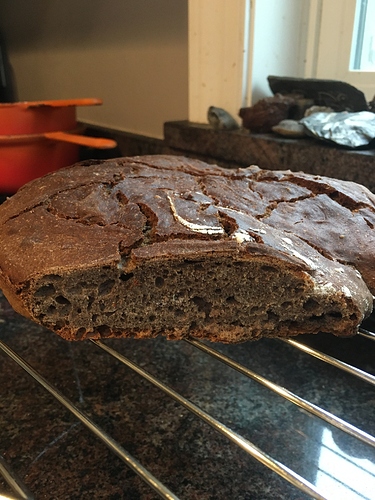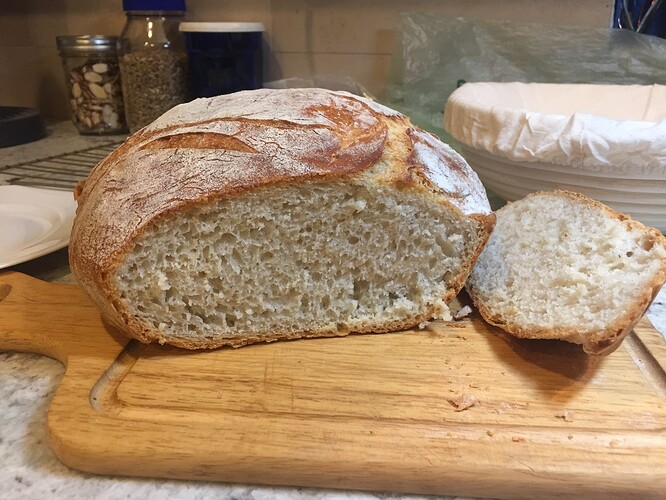I recently found this website and this recipe. I’ve made it several times in the last two weeks, and have played around with varying the types and amounts of flour. The bread turned out beautiful and delicious every time! This is now my “go to” recipe. Thank you for the video tutorials which helped a lot!
Hello Eric and/or Melissa,
I made this no-knead bread recipe with Jovial Einkorn AP Flour, altho found the dough to be exceptionally-off-the-chart wet (weighed all ingreds accurately using grams, as I typically do).
18 hour bulk fermentation
36 hour refrigeration
dough was so gloppy, I sprinkled bread flour 1TBL at a time across top, folding & pressing into dough using flexible plastic dough scraper and constantly turning, up to about 1/4C total and then stopped fearing addtl flour might transform it into a lead brick; decided to proceed as-is
90 min counter rest in the bowl bringing dough to room temp
then “poured” thick still-gloppy dough into parchment-lined banneton for 2 hour proof rise, but didn’t really rise; just expanded very nominally
transferred dough blob with parchment lining to the hot dutch oven in preheated oven 450d
baked 30min covered & 20min uncovered
see attached images; little bit of oven rise, but essentially a condensed spaceship
Q1) why do suppose the dough was so gloppy? anything dif/unusual abt einkorn flour’s absorption?
Q2) why didn’t the dough rise during second 2hr proof? was it too wet to rise?
Q3) according to my steps described above, was there anything in my process off-road & botched up?
I’d appreciate your feedback and suggestions; thanks so much for your guidance!
~ Patricia
Einkorn is a low gluten flour and behaves unique unto itself. I love the flavor and think it is very much worth learning to work with.
Jovial Foods info has concise info: See Einkorn - Baking with Einkorn. Then Recipes - Einkorn and there is a recipe for an Einkorn boule (no knead as really, you don’t knead Einkorn)
You can search Einkorn in this forum and find a number of Einkorn specific recipes. A recent recipe and one that I have made several times:
Naturally leavened Einkorn (sandwich loaf). I like the enriched version and use my normal white flour starter. I’ve also subbed up to 45% white flour to get a loaf that I can shape and is more toward the artisanal.
There is also a discussion Observations about heirloom and ancient wheat which includes a lot of info on working with Einkorn. @anon44372566 wrote a recipe that is similar in hydration to the Jovial recipe but with nice round numbers  … it is somewhere in the middle of the thread.
… it is somewhere in the middle of the thread.
So, summary … answers to all 3 questions is too much water for Einkorn and not the best recipe/method for Einkorn.
AND … despite the frustration, your loaf looks good and I bet it tastes great!
Hello Liz, thanks so much for the info. ack! It’s clear now that I jumped in the ocean w/o chkg water conditions:) and yet w/o researching abt the flour, it was an interesting sensory experience noticing how silky-fine the flour felt in comparison to AP and bread flour and observing how the flour behaved. I’ll chk out those links/threads and dive in again.
Your bread looks great for all the trails and hydration  Yep, what Liz said (thanks, Liz!) It’s not particularly absorbant. I agree that it’s so silky and I love that it even sounds different when being milled.
Yep, what Liz said (thanks, Liz!) It’s not particularly absorbant. I agree that it’s so silky and I love that it even sounds different when being milled.
My first use of my new cloche, following the revised recipe-except I used 1 cup buckwheat flour instead of wheat, and used active dry yeast instead of instant (properly proofed in warm water). Disaster! Hahaha. Under-cooked inside, no rise on the second proof.
Can I use the no knead recipe and shape into oblong loaf and bake in oblong cloche?
Yes, the oblong shape and baker will work fine.
i Have been doing my bread this way from the beginning & having no trouble at all, even from my first loaf, Very easy to do if you take your time and read the instructions. Tom from Ky
This is exactly what I did. With a little less water in the mix, after the second proof in the proofing basket, the dough is a bit firmer and holds its shape better. Also I can make the razor cut more easily.
I also like the NY Times Cooking section recipe on sourdough bread, which I use for this NK bread with regular active yeast. Basically, I like mixing the flour and water first and let sit to autolyse for 30 minutes or so. Then I add the yeast, and fold the dough like in Eric’s video. Then add the salt.
I find the dough has more gluten this way and holds shape better. Then rather than letting the dough sit overnight. I do the folding of the dough for 10-15 minutes, and that really builds the gluten (window pane test). After that I then just do the four folds every 60 minutes for the next 3-6 hours - this is when bulk fermentation occurs and the dough gets airy and doubles in size.
After that, the tri fold thingy that Eric does before putting the dough into the proofing basket is key. I think that helps maintain shape as well.
First bread and so happy! Can’t want for loaf #2 and 3 and 4 and…
Thank you Breadtopia and Eric for your wonderful videos. I did a fair amount of reading about bread making but the videos brought it all to life.
Nana Pacheco
I plan to make this bread, but the only Dutch oven I have is a stainless, All-Clad Dutch oven. Would it be ok to bake the bread in a steel Dutch oven? If so, should I change the temperature settings or the cooking duration? Also, should I line the inside of the pan with anything to make sure the dough doesn’t stick? Thanks!
All Clad website says the stainless DO is safe up to 600F but also “extended exposure” at temps over 500F will cause color changes to the steel but not affect performance. This info is under “item care.”
Maybe preheat less time (there is less thermal mass) and to 450F max. Use parchment paper under your dough to prevent sticking.
